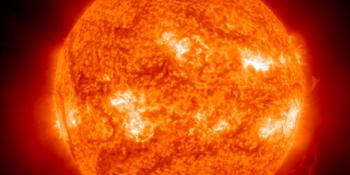Przeglądasz Archiwum z środa, 13 lipca 2005
Raport aktywności słonecznej
Każdy wspomniany rozbłysk słoneczny w tym raporcie ma współczynnik skalowania dodany przez Space Weather Prediction Center (SWPC). Przez skale współczynników SWPC, raporty o rozbłyskach słonecznych są o 42% mniejsze niż naukowo jakościowa data. Skale współczynników zostały usunięte z naszych archiwów o rozbłyskach słonecznych by odzwierciedlić prawdziwe jednostki fizyczne.
Raport aktywności słoneczno- geomagnetycznej 2005 Jul 13 2230 UTC# Prepared jointly by the U.S. Dept. of Commerce, NOAA, #Space Environment Center and the U.S. Air Force. #
Połączenie raportów USAF/NOAA o słonecznej i geofizycznej aktywności
Numer SDF 194 wydany w 2200Z na 13 Jul 2005IA. Analiza aktywności regionów słonecznych i aktywność od 12-2100Z do 13-2100Z Solar activity increased to high levels. Region 786
(N11W84) continues its very active ways as it rotates around the
west limb. The region was responsible for all flare activity this
period, which included numerous C-class x-ray flares and five
M-class events. The largest and most impressive of these events was
the long duration M5 flare at 13/1449Z. Moderate to strong
centimetric radio bursts accompanied this event including a 2000 sfu
Tenflare. A bright, fast, predominantly westward directed CME (1360
km/s) was also observed. A long duration M1 x-ray event and Tenflare
(250 sfu) occurred at 13/0316Z. A CME was also observed on LASCO
imagery following this event. A relatively impulsive M3 flare
occurred at 13/1219Z. Region 786 is a moderate size sunspot group
with a strong delta configuration. New Region 790 (S10W35) was
numbered today.
IB. Prognoza aktywności słonecznej
Solar activity is expected to continue
at moderate to high levels for one more day as Region 786 rotates
around the west limb. Activity is expected to return to low to very
low levels on 15 and 16 July.
IIA. Podsumowanie aktywności geofizycznej 12-2100Z do 13-2100Z
The geomagnetic field ranged from quiet to minor storm levels. Solar
wind parameters indicated the arrival of new CME material at the ACE
spacecraft early this period. Extended periods of southward IMF Bz
and solar wind speeds exceeding 600 km/s resulted in active to minor
storm conditions at all latitudes. The greater than 10 MeV protons
are slowly rising following today's M5 flare. The greater than 2 MeV
electron flux at geosynchronous orbit was at high levels again
today.
IIB. Prognoza aktywności geofizycznej
The geomagnetic field is
expected to range from quiet to major storm levels. The CMEs
observed yesterday and today are expected to produce active to minor
storm levels on 15 and 16 July. Isolated major storm periods are
possible at high latitudes. The greater than 10 Mev protons will
likely pass the 10 pfu alert threshold early on 14 July.
III. Prawdopodobieństwa zdarzenia 14 Jul do 16 Jul
| Klasa M | 50% | 20% | 10% |
| Klasa X | 10% | 01% | 01% |
| Proton | 20% | 10% | 05% |
| PCAF | yellow | ||
IV. Przepływ 10,7 cm z Penticton
Zaobserwowano 13 Jul 092 Przewidywane 14 Jul-16 Jul 090/085/080 Średnia z 90 dni 13 Jul 097
V. Indeks geomagnetyczny A
Zaobserwowano Afr/Ap 12 Jul 017/048 Szacowane Afr/Ap 13 Jul 020/030 Przewidywane Afr/Ap 14 Jul-16 Jul 015/015-020/025-020/025
VI. Prawdopodobieństwa aktywności geomagnetycznej 14 Jul do 16 Jul
| A. Średnie szerokości geograficzne | |||
|---|---|---|---|
| Aktywne | 25% | 40% | 40% |
| Słaba burza | 15% | 20% | 20% |
| Bardzo znacząca burza | 05% | 10% | 10% |
| B. Wysokie szerokości geograficzne | |||
|---|---|---|---|
| Aktywne | 30% | 50% | 50% |
| Słaba burza | 20% | 30% | 30% |
| Bardzo znacząca burza | 10% | 15% | 15% |
Wszystkie czasy w UTC
<< Idź do codziennego przeglądu
Najnowsze wiadomości
Najnowsze wiadomości z forum
AR 3959 5SEEDS is down? 18Space Weather Memes 653IP cameras for sky surveillance 38Incoming & Unnumbered Active Regions 1399
Więcej tematówWesprzyj SpaceWeatherLive.com!
Wielu ludzi odwiedza SpaceWeatherLive aby śledzić aktywność słoneczną lub sprawdzić czy jest szansa na zaobserwowanie zorzy polarnej. Niestety, większy ruch na stronie oznacza większe koszty utrzymania serwera. Dlatego, jeśli jesteś zadowolony ze strony SpaceWeatherLive, zachęcamy do wspierania nas finansowo. Dzięki temu będziemy mogli utrzymać naszą stronę.

Fakty na temat pogody kosmicznej
| Ostatnie rozbłyski klasy X | 2025/01/04 | X1.85 |
| Ostatnie rozbłyski klasy M | 2025/01/09 | M1.1 |
| Ostatnia burza geomagnetyczna | 2025/01/04 | Kp5 (G1) |
| Dni bez plam słonecznych | |
|---|---|
| Ostatni dzień bez skazy | 2022/06/08 |
| Średnia miesięczna liczba plam słonecznych | |
|---|---|
| grudnia 2024 | 154.5 +2 |
| stycznia 2025 | 144.5 -10 |
| Ostatnie 30 dni | 151.1 +32.8 |


